Scrum vs Agile in 2025: Understanding Project Management Principles & Methodologies
Picking a new project management methodology can be challenging because there is so much to consider. The fact that you're here means you're weighing up your options between Scrum vs Agile methods. This guide will show you the similarities and differences between both.
Key Takeaways: Scrum vs Agile
- The main difference between Scrum and Agile is that Agile is a philosophy and set of principles, where Scrum is a specific Agile-based methodology.
- All Agile methods are free-flowing, flexible and communication-heavy, which allows teams to change course easily and work more efficiently.
- The Scrum method has the same basic Agile framework but is more structured, suitable for small teams that can have daily Scrum meetings.
The Scrum method is a favorite with software developers thanks to its structure and flexibility. However, many Agile methods offer these benefits, too; so how do you choose between Agile vs Scrum? Reading this guide is the first step you should take. We mention some of the best project management software platforms that support Agile and Scrum, and cover what makes each method tick.
In this guide, you’ll learn what Scrum and Agile are, their differences and how each method can benefit (or hamper) you. We even throw in information about linear and hybrid methodologies and how they compare to Agile. Let’s get into it.
Comparing Scrum vs Agile
Our team of experts is well-versed in all things Agile and Scrum, and we use both daily. We have even put together lists of the best Scrum software and the best Agile software so that you can find the best software for you and your team. Let’s start with the basics.
What Is Agile?
Off the bat, Agile is a set of principles and guidelines that form a working iterative process and framework. Let’s make it clear that there isn’t an Agile methodology, per se.
Avoid Costly Project Management Mistakes – Get Free Tips Today!

- Discover 10 fundamentals of project management
- Understand step-by-step plans for PM execution
- Learn tips to avoid 5 common mistakes by beginners
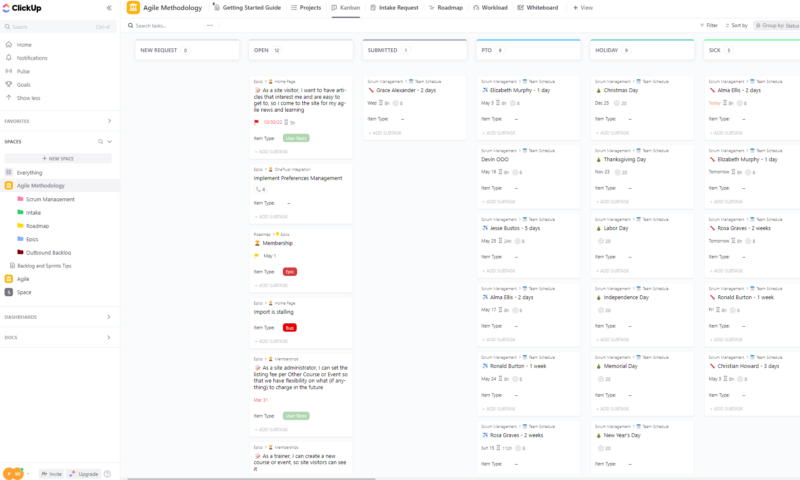
Agile was born when a software development group became frustrated with the Waterfall method (you can learn more about the waterfall method in our guide to project management methodologies). The philosophy and framework that was created helped birth specific Agile methodologies like Scrum, Extreme Programming (XP) and other Agile methods.
The group made an Agile manifesto that puts value in individuals and interactions over processes and tools, working software over comprehensive project documentation, customer collaboration over contract negotiation, and responding to change by following a plan. Because of its flexibility, many teams prefer Agile work styles.
What Is Scrum?
Scrum is an Agile project management methodology that’s often used by software developers. Scrum encourages accountability, teamwork, communication and an iterative approach to project management. Learn more in our Scrum history guide.
The Scrum framework is adaptable, which means that should a client’s needs change, the Scrum team can pivot and pull in different directions as needed. To run effective team meetings, check out what is a sprint review or what Scrum Anti-Patterns are .
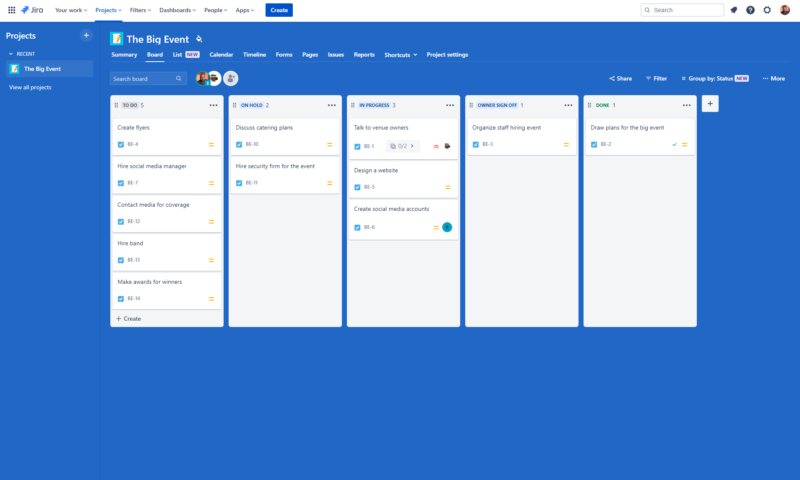
Scrum is more structured than other Agile methods, but is still a fluid project management process. It looks complicated, but once you understand it, you’ll discover that there’s nothing to be scared of. Scrum basically takes a backlog of tasks and assigns the work to a team who needs to complete said tasks in a set amount of time. These work periods are called sprints.
Scrum teams typically have more structure. Teams are broken down into three categories. First, you have the developers who work on the project. Second, a product owner works with stakeholders to create the project’s vision. Lastly, there’s the Scrum master, who understands the Scrum framework and leads the team through the Scrum process. Scrum teams usually have 10 members or fewer.
Agile vs Scrum: Similarities & Differences
The two working styles have a few things in common, since the Scrum method was born from Agile project management processes and philosophies. However, there are some significant differences, too. We’ll cover the similarities and differences below.
Agile vs Scrum: Similarities
Whether your team focuses on Agile software development or a different type of work, Agile processes will provide your team with many core similarities. Why? As stated above, Agile is a set of philosophies and processes, and Scrum was built around the Agile process.
Boards
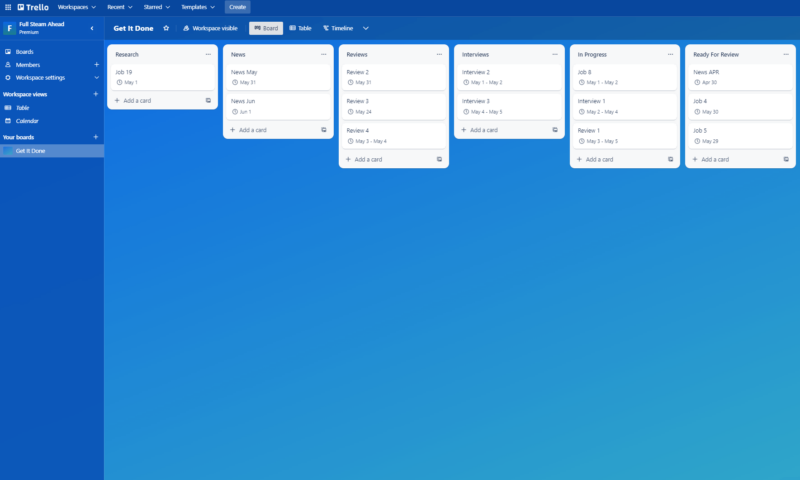
a kanban board can have significantly more.
Scrum and other Agile methods use boards as a visual aid. If you’re unfamiliar with them, check out our guide to kanban boards. However, it’s worth noting that Scrum and Kanban differ, and that, technically, Scrum uses Scrum boards, a modified Kanban board. The boards operate similarly but differ in the naming convention for columns that host the task cards.
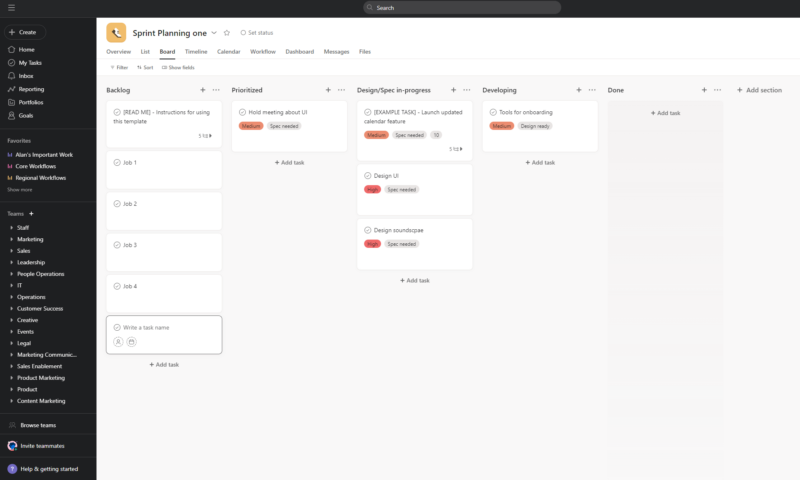
kanban boards will not.
Flexibility & Collaboration
Scrum and Agile methods are flexible and allow teams to respond quickly to new demands or problems. Both methods involve team collaboration and have elements of Lean processes (waste reduction and efficiency). Because one can’t exist without the other, Scrum and Agile will always share the same core principles, philosophies and processes.
Agile vs Scrum: Differences
Now for the differences. Scrum was born from Agile, and those who developed Scrum built a framework on top of Agile principles. Compared to other Agile approaches, Scrum is quite structured and requires a fair bit of project management training to implement correctly. Every team member (up to 10) must also be completely on board with the process for Scrum methods to work.
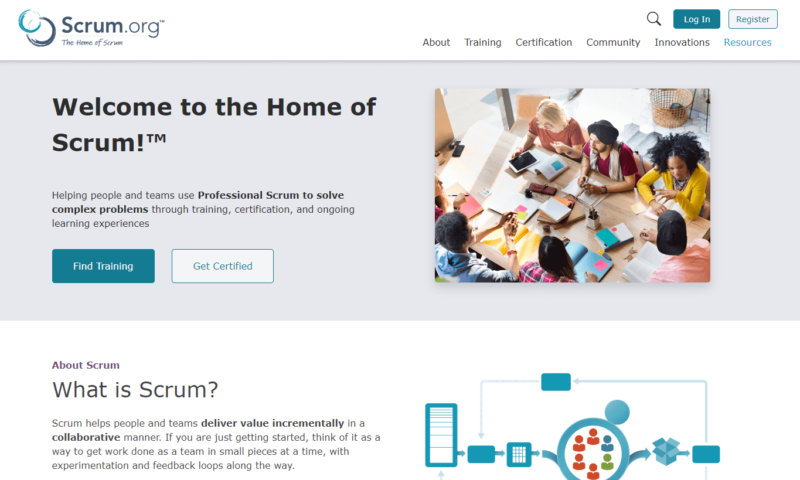
Sprints
In Scrum, the Scrum master guides cross-functional teams through projects that are broken down into sprints and facilitates practices such as backlog refinement. During sprint planning, tasks are pulled from a backlog and assigned. Sprints must be completed in a set amount of time, usually two to four weeks. At the end of the sprint, you rinse and repeat until all tasks are complete and the deliverable has been handed over to the client.
Other Agile solutions do not utilize sprints and feature a less structured approach to assigning and completing tasks. Instead of there being timed blocks, work is delivered regularly for feedback instead of being held back for up to four weeks.
Meetings & Accountability
Another difference is that, while other Agile methods rely on face-to-face communication, Scrum project management requires daily stand-up meetings where the team and the Scrum master discuss task progress and any issues that may have arisen. If you like accountability, you’ll enjoy Scrum more than other Agile methodologies.
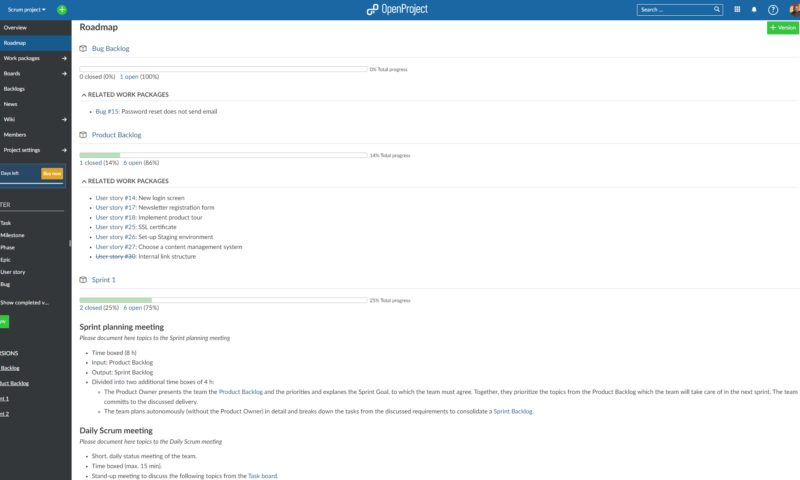
allow you to create Scrum road maps and daily Scrum agendas.
Most Agile and Scrum methods differ in a few areas, but are ultimately the same. All use the same core philosophies and principles. The differences are found in the methods used to complete work.
Ultimately, with any Agile approach, the customer always comes first. Work is more important than creating endless documents. Collaboration is critical, and being able to react to change is vital.
Which Is Better: Scrum vs Agile?
As a project manager, you’ll need to decide which Agile methodology fits your team and the project you’re working on. If you’re working solely on developing software, Scrum will likely be the better choice. Still, you can’t discount other Agile methodologies, like Extreme Programming or Kanban. There’s simply no one-size-fits-all methodology, as each has its strengths and weaknesses.
We Recommend Scrum If You Want…
- Increased accountability: Daily Scrum meetings foster communication between team members and Scrum managers, to increase accountability.
- More structure: Scrum’s structured approach to work can help teams stay focused and meet deadlines.
- To work with small teams: Scrum works best with teams that contain up to 10 team members.
We Recommend Agile If You Want…
- Consistent communication: All Agile methods rely on teams that can communicate effectively and consistently.
- More flexibility: Many Agile methods aren’t as structured or rigid as Scrum, which means your team has more flexibility.
- To work with larger teams: Most Agile methods work very well with larger teams, both in the office and remotely.
Other Agile Project Methodologies
Throughout this guide, we’ve mentioned “other Agile methodologies.” Now, we will quickly examine some of the other Agile options that might work better for you than Scrum.
Kanban
Kanban is a widely recognized Agile project management philosophy. Project managers can create columns representing stages, departments and even team members, and then create task cards that sit in those columns. Users then simply drag and drop the cards from left to right to signify the task progressing through the project lifecycle.
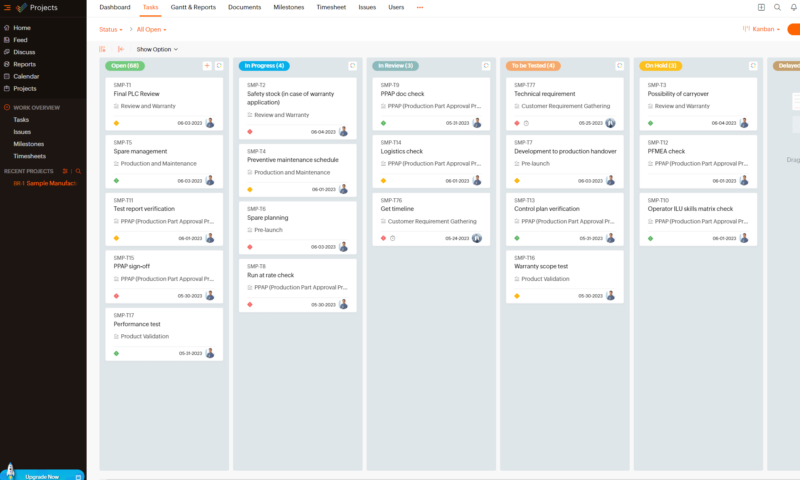
Kanban is easy to master and provides a powerful overview of the project you’re working on. Kanban can also stop team members from becoming overworked, as it’s easy to implement work-in-progress policies (you can see how many task cards an individual is assigned to). If kanban is something that interests you, check out our roundup of the best software for kanban.
Lean Method
The Lean method, which is built upon the three M principles — muda (wastefulness), mura (unevenness) and muri (overburden) — has been shown to help eliminate waste and increase the efficiency of companies working in manufacturing sectors.
Like many other Agile methods, Lean relies on Kanban boards and lists to track tasks because they provide excellent overviews. Managers can quickly see wasteful jobs, work backlogs and if employees are overworked.
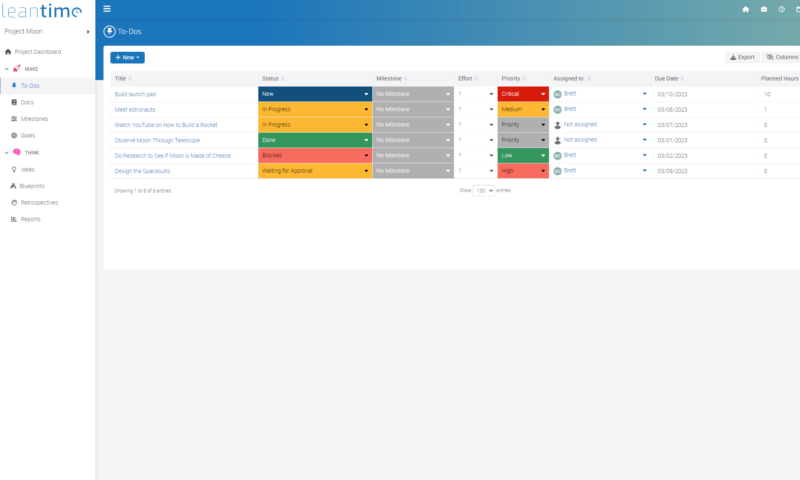
Users of Lean methods need to be careful, though. Running a Lean ship means there’s little room for error. Any problems that pop up can snowball in a hurry. Many project management tools can help you facilitate Lean methods, but we recommend Leantime. Be sure to read our Leantime review before you take the plunge.
Agile vs Other Project Management Philosophies
If you want to anger the Agile manifesto gods and use a more traditional project management style (linear) or a hybrid method, we’ve got you covered. Below, we’ll look at a few of the options.
Agile vs Waterfall
The Waterfall method of working couldn’t get any further from the Agile philosophy if it tried. The Waterfall method, which is incredibly rigid and not for those who need to pivot quickly, is the exact style of work the Agile Manifesto founders were trying to get away from, but this doesn’t mean it’s bad. In fact, for many outside of software development, it’s ideal.
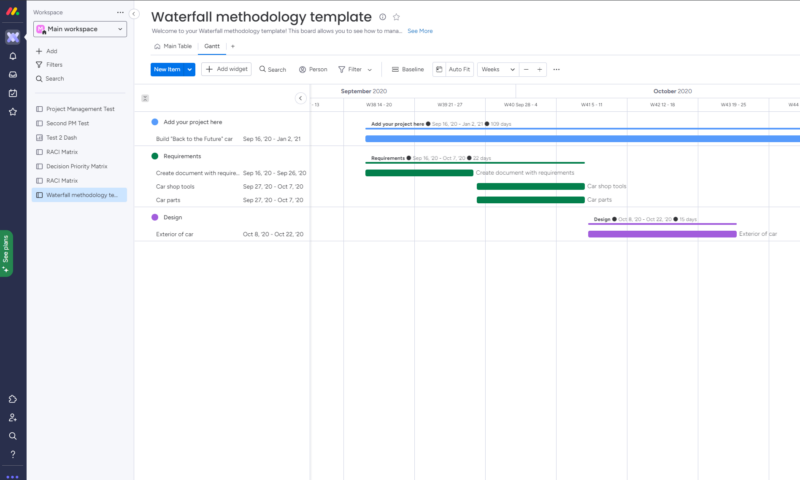
In the Waterfall method, project managers and teams rely heavily on Gantt charts. Don’t let this scare you, though; Waterfall is easy to learn and implement. In Waterfall, projects are split into five phases (setting requirements and document gathering, planning, development, testing, deployment and support), and each phase contains tasks.
Teams work through each phase by completing the tasks. Once complete, teams fall down the “waterfall” to the next phase. However, this method can create problems. Once a phase is complete, it can be hard to go back and rectify problems.
The Waterfall method could be for you if your projects have clearly defined goals with end results that don’t change. Be sure to look at our best Gantt chart software roundup if you go this route.
Agile vs Hybrid
If you like the idea of a methodology that uses traits from Agile and linear methods, you’re in luck. Hybrid methods are quite popular thanks to their flexibility. Project managers and teams can alternate between using free-flowing kanban boards and more-rigid Gantt charts, and have a project structure in place while still being able to change course if needed.

Several well-known and respected methodologies are considered hybrid. The PRINCE2 method (read our guide on What Is PRINCE2), Scrumban, Critical Path Method and Six Sigma are all hybrids. Just keep in mind that many of these methods are incredibly complex and can be hard to implement. Gaining certifications in each is highly recommended. We’ve curated a list of Agile certifications that can help enhance your project management skills.
The Verdict: Agile vs Scrum
There are compelling reasons to use Agile or Scrum methods, but ultimately, only you can decide which is right for you. No project management methodology is better than another; it all depends on your team, the project and the client’s needs. Pick the Agile methodology that suits you, learn all there is to know about it and then knock your projects out of the park.
Do you use Scrum or another Agile method? Which Agile way of working is your favorite? Would you switch to the waterfall method, or perhaps try a hybrid methodology like Scrumfall? Let us know in the comments, and as always, thanks for reading.
FAQ: Agile vs Scrum Compared
Yes. Scrum uses the philosophies outlined in the Agile Manifesto.
Agile is a set of principles that a team of software developers put together to avoid the rigid waterfall method. In contrast, Scrum is a methodology with a framework built around Agile principles.


